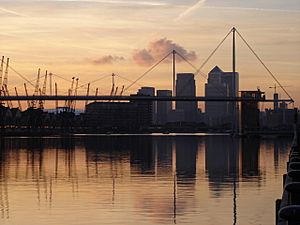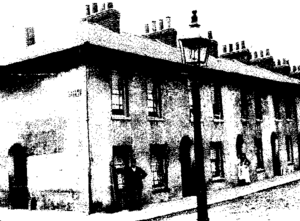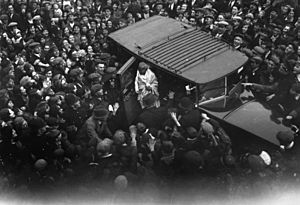Canning Town facts for kids
Quick facts for kids Canning Town |
|
|---|---|
 Royal Victoria Dock - with Canary Wharf and the O2 Arena in the background |
|
| Population | 42,667 (Canning Town North And Canning Town South wards, 2021) |
| OS grid reference | TQ4081 |
| London borough | |
| Ceremonial county | Greater London |
| Region | |
| Country | England |
| Sovereign state | United Kingdom |
| Post town | LONDON |
| Postcode district | E16, E13 |
| Dialling code | 020 |
| Police | Metropolitan |
| Fire | London |
| Ambulance | London |
| EU Parliament | London |
| UK Parliament |
|
| London Assembly | |
Canning Town is a lively area in East London, England. It's part of the London Borough of Newham and sits just north of the Royal Victoria Dock. This area grew a lot because of the dock, which brought many jobs and people.
Canning Town was once part of Essex, a historic county. Today, it's known for its ongoing changes, with many new homes being built to make it an even better place to live.
Contents
History of Canning Town
Before the 1800s, Canning Town was mostly marshland. You could only reach it by boat or by paying a fee to cross a bridge.
Building Roads and Bridges
In 1809, a special law was passed to build the Barking Road. This road connected the East India Docks to Barking. A new iron bridge was built in 1810 to carry the road over the River Lea. This bridge was replaced several times over the years. Today, you can see parts of the old bridge supports used for a footbridge that links Canning Town to Leamouth.
How Canning Town Got Its Name
The area is believed to be named after Charles John Canning, who was the first Viceroy of India. He was an important figure around the time Canning Town started to grow.
Growth and Industry
The population of Canning Town grew very quickly after 1846. This was when the North London Line railway was built from Stratford to North Woolwich. The railway helped move coal and goods from the docks.
Many houses were built for workers who came for new jobs. These jobs were in chemical factories, the Thames Ironworks and Shipbuilding Company, and the Tate & Lyle sugar refinery.
The Royal Victoria Dock
The Royal Victoria Dock opened in 1855. This was a huge event that created many jobs. It also led to new communities like Hallsville, Canning Town, and Silvertown.
However, these new areas often lacked clean water and sewage systems. This caused health problems like cholera and smallpox. Many dock workers were poor, leading to difficult living conditions.
Community and Activism
The industries around the docks could be unhealthy and dangerous. This led to people working together to fight for better living conditions. Important figures like Will Thorne and James Keir Hardie became leaders in the Labour Party. They often gave speeches at the Canning Town Public Hall.
A Diverse Community
From the late 1800s, many African sailors settled in Canning Town. This was because of new shipping routes to the Caribbean and West Africa. Before the Windrush era, Canning Town had London's largest Black population. An area called Crown Street was even known as Draughtboard Alley because of its mix of people.
Famous Black people from Canning Town include footballers Fred Corbett and Jack Leslie. Jack Leslie was even chosen to play for England but then dropped, possibly due to unfair reasons.
Another example of the area's diverse history is Dr. Chuni Lal Katial. He was an Indian-born doctor who practiced in Canning Town. In 1931, he invited Mahatma Gandhi to meet Charlie Chaplin at his office. Gandhi was in London for important talks about India's future.
The Silvertown Explosion
In 1917, a huge explosion happened at an ammunition factory in nearby Silvertown. This was the Silvertown explosion, the biggest explosion in London's history. It damaged over 70,000 buildings and sadly killed 73 people.
World War II and Rebuilding
Canning Town was hit very hard by bombs during World War II. About 85% of the homes were destroyed. After the war, the council planned to rebuild the area. They wanted to reduce the population and build new housing estates with schools and welfare services.
In 1940, a bomb hit South Hallsville School, where many local people were staying for safety. Many were killed or injured.
The war and earlier efforts to improve housing led to many council estates being built. These new homes followed ideas from the garden city movement, which aimed for green and pleasant living spaces.
In the 1960s, the first tall apartment buildings were built. However, after part of a 22-storey tower block called Ronan Point collapsed in 1968, many tall buildings in the area were either taken down or made smaller.
Living Conditions in the Past
In the past, Canning Town faced many challenges with housing.
Victorian Times
In 1857, a writer named Henry Morley described Canning Town. He said that because it was outside London's main building rules, new streets were built without proper drains, roads, or gas. This meant people lived in very basic conditions.
Many people lived in overcrowded homes because landlords charged high rents. Workers often had unstable jobs, making it hard to afford better housing.
20th Century Improvements
In the 1890s, a new law made local councils responsible for providing good homes. Some of the first council houses were built in Bethell Avenue. However, many older houses were still very poor. The council started to clear these "slums" in the 1930s and built the first tall apartment blocks.
Canning Town Today
Today, Canning Town and Custom House are still considered areas that need support. Many residents face challenges like poor health, lower education levels, and poverty. The local council is working hard to improve these conditions.
Regeneration Project
Canning Town is currently undergoing a huge project to make it better. This project is worth £2.7 billion! It involves local leaders, residents, and businesses working together.
The council wants to create new homes and spaces that people will love. They are especially interested in building terraced housing, which is popular with families.
The project includes:
- Taking down 2,750 old homes and building 10,000 new ones.
- Creating a new town centre with shops and offices.
- Building new community places like a library and a health centre.
- Making improvements to local primary schools.
Culture and Fun
Canning Town has some interesting cultural connections.
- Thames Ironworks F.C., a football team from the local ironworks, later became the famous West Ham United F.C..
- The Bridge House was a popular music venue in the 1970s and 1980s. Many famous bands played there, including The Police and Iron Maiden.
Education
For more details on schools in Canning Town, you can look at the List of schools in the London Borough of Newham.
Transport
Canning Town is well-connected by public transport. Many London Buses routes serve the area, including routes 5, 69, 115, 147, and others. There are also night bus routes.








